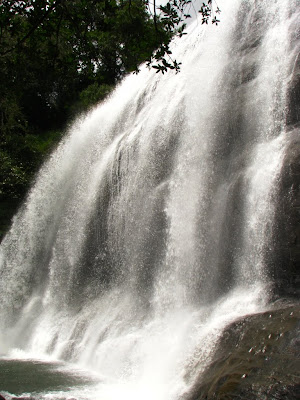Trip to Dubare,Siddapura,Ammathi, Bhagamandala and Talakaveri:
As per our initial plan we were supposed to cover three places i.e. Igguthappa temple, Nalknad palace and Chelvara falls in the first half of the day and then head back to Bangalore. The jeep arrived at 8 AM in the morning. After having breakfast we headed towards our first destination, the temple. We had to take the same route that we had travelled the previous night to reach the temple.
The route: Virajpet - Karada - Kakkabe
Igguthappa Temple
Igguthappa Temple is dedicated to lord Igguthappa (another name for Lord Subramanya). Igguthappa is the main deity of Kodavas, situated at Kakkabe small village near Virajpet. In Kodava language “Iggu” stands for Food and “Thappa” stands for provider.

The devotees believe in the miracles by Lord Igguthappa, where one can ask for anything. Tulabhara, weighing oneself against fruits, sugar, coconuts, rice etc, is an important offering here.
Our next Destination was the Nalknad Palace

The guard of the palace volunteered to take us around the palace. The palace mesmerizes everybody with its exquisite wall paintings, intricate wooden carvings. The palace has a Darbar hall on the first floor, but don’t be fascinated by the paintings on the roof since it was done by some film crew few years ago for their film shoot. At that time the palace was yet to be taken over for renovation by government.It is sad to see such a place being tampered for one’s personal benefit.
The guard also showed us around various rooms which were covered with exquisite paintings. Out of his own interest he had it covered with polythene so that it won’t be tampered with by the visitors.
He also showed us around the hiding place for the king, in case of any attack. It was a dark and a narrow passage which also leads to the entrance of the palace, but well hid.
Our next destination on list was the Chelavara falls:
The route: Virajpet - karada - Kadanga - Cheyyendane - Chelavara village
Chelavara falls is one among the most beautiful waterfalls in Coorg, yet it is relatively unexplored. This is approximately 4km from the Cheyyendane village. The waterfall is a wonderful view, situated amidst the coffee plantation.

A walk for about 10min takes us to the bottom of the waterfall, which provides the spectacular view. One can also reach the top side of the falls and can get a spectacular view of the falls with lush greenery all around.

It took us almost 5 hours to cover all the three places and had to thank the rain god for having mercy on us J . It was a fantastic weather to visit these places, chilly in the morning when we started and remained cloudy all the way on our trip. We reached the hotel back at around 1 pm.
We decided to head back to Bangalore in a different way, i.e. via Nagarhole and visit Irpu falls on the way as we had enough time left on our hands. This was initially not part of our two day plan.
The route:
Virajpet - Gonikoppal - Ponnampet - Kutta - Srimangala
Irpu Falls
Irpu falls, which is around 45kms from Virajpet. The tributary of river Cauvery, the Lakshmana Tirtha River has its source in this falls. This fall is a major tourist attraction along with a pilgrim sight.
One has to walk along the guided path for about a 1 km from the temple at Irpu to reach the falls. It is located on the Brahmagiri range. The falls creates a spectacular view with water plunging down in three tiers of approx 60m height, creating deafening noise that could be heard from a distance.
According to a legend lord Rama and his brother Lakshmana passed along the Brahmagiri range. When lord Rama asked his brother to get some drinking water, Lakshmana shot an arrow at the Brahmagiri hills which started spurting water. This stream of water came to known as the Lakshmana Tirtha River. Due to this legend many pilgrims visit the Irpu Falls to wash off their sins.
There is a trekking route available over here where one can reach the peak of Brahmagiri hills. One has to contact the forest department for the arrangement.
We spent close to 1.5 hours here capturing some spectacular view of the falls.
To reach Bangalore we had to go via Nagarhole national Park and we had to be there before 6pm, since Karnataka government has imposed restriction for entry of vehicles after 6 pm for the safety of the wild life. We had to hurry as it was close to 4:00 pm and we were 25-30km away from the entrance of the national park. The road leading to the park is not that good. We reached the entrance at around 5pm.
The Nagarhole reserved forest stretches for a distance of about 45km. It is a treat for the eyes when travelling through this sanctuary, with greenery all around. Also during this part of the year (monsoon) the forest comes alive with greenery with sprouting grass alongside the road. This entire stretch is known to be the habitat for Asian Elephants.


We reached Bangalore at around 11pm troubled by rain all over from Mysore. It was indeed an exhausting but a wonderful trip experience in the monsoon season!!!








